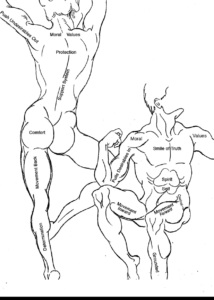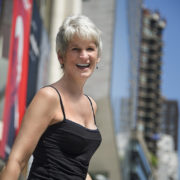BodyLogos Blog
Welcome to the BodyLogos blog. Here’s where you’ll get your dose of alignment and balance with grace. (Sign up here to join 1,000 other blog subscribers.)
Redefining Strength
I want to change our perception of strength. Strength is the ability to meet resistance and influence an outcome without compromising ourselves. And we already have it.
Strength is not an attribute; it’s a state of being. Gladiators, bodybuilders, and football players demonstrate strength through brute force, sheer willpower, muscle mass, and relentless pursuit. But we’re also quick to identify dancers and martial artists as strong. Their medium taps into a sense of vulnerability, balance, alignment, controlled power, and grace—but no one can deny their strength. Strength may look different on each of us, but it is an inherent part of who we are.
You are not weak by nature; you are stronger than you think. Your strength is not something you need to kill yourself to gain—it is already within you, waiting to be excavated. The key is to stop chasing something you already have and tap into it, so you can manifest that strength in your everyday life.
Because we don’t think we’re strong, we approach resistance with the idea that we’re not enough. We throw everything we have at it and push past our physical, mental, and emotional limitations. We see strength as domination, but it’s not.
When you learn to listen to your body’s divine wisdom, you cultivate a sense of where your body is developing tension instead of standing in its strength. You end the vicious cycle of unrealistic expectations, injury, and self-criticism and learn how to consciously embrace responsible growth. You stop compartmentalizing your strength into emotional, physical, and mental pieces and operate from the strength of your being at all times.
You learn how to align yourself with gravity—instead of working against it—so you can channel your strength to meet life’s resistance. As you meet resistance with equal parts power and alignment, you transform tension into strength
As in the sword dance above, the power lies in bringing just the right amount of force—not too little and not too much. By meeting the sword’s weight, I meet gravity. I am tapped into a larger source of energy, free of tension, and discover a strength that is wholly and uniquely mine.





 About Tammy Wise
About Tammy Wise
The Foundation for Focussed Strength Dive Deeper Into The Art of Strength: Preview Chapters 3 & 4 of My First Book
by Tammy WiseThe BodyLogos Philosophy: Now In Book/Video Form!
Whether you’re a visual, aural or verbal learner, you’ll discover how to
release tension and build strength.
Order your copy of The Art of Strength: Sculpt the Body ~ Train the Mind, a pioneering book/3D video learning system today!
The Foundation for Focussed Strength
Dive Deeper Into The Art of Strength: Preview Chapters 3 & 4 of My First Book
I’ve got a question for you: How’s your relationship with gravity?
Well, we’re pretty close, Tammy. After all, I’m tethered to the ground at this moment, not floating around in the atmosphere, you might think with a chuckle, humoring my query.
I ask because building a healthy relationship with this powerful force takes much more than just passively carrying your weight around. It involves active engagement with your presence on this Earth and recognizing the Divine arrangement of it all.
Chapters 3 and 4 of my brand-new book, The Art of Strength: Sculpt the Body ~ Train the Mind, help you explore our vital connection to gravity so that you can approach any physical or mental challenge that comes your way from, you guessed it, a place of strength.
Here’s a quick anatomy lesson. Your Central Plumb Line vertically aligns your body with the Earth’s gravitational pull—think of it as your personal axis, connecting your North Pole (your crown) to your South (the bottoms of your feet); this is why I also often refer to it as your Vertical Plumb Line. When this line is out of whack, it’s fighting gravity. The negative effects of that battle are both mental and physical: a distorted spine and constricted central nervous system, along with a feeling that your drive to do and be your best is being crushed.
But when it’s in Neutral Alignment, all is well. Then, your relationship with gravity puts your energy, bones, and muscles in their optimal positions. You have a solid foundation for physical strength and focused attention.
So how do you navigate this neutrality? Achieve such alignment?
By getting to know the five Energy Centers that make up your Vertical Plumb Line and the corresponding Alignment Stabilizers that horizontally straddle each Energy Center, you can effectively fine-tune your alignment.
In chapters 3 and 4, I share simple yet profound exercises that help you:
The book gives you exclusive access to videos that help visually guide you through these exercises.
With your energy centers and bones aligned, you can move fluidly to meet with outside resistance—physically, mentally, and emotionally.
You learn that alignment isn’t static—it’s constantly in flow. In fact, the difference between tension and strength is that tension is static while strength is fluid. Your alignment liberates you to stretch and move.
By aligning your physical, mental, and spiritual dimensions, you’re free—free to express yourself and live in your truth and in your power.
Get your copy of The Art of Strength: Sculpt the Body ~ Train the Mind today!
Balboa Publishing
with a 5% gift to Safe Horizons
Amazon